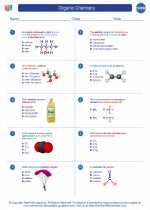Organic Chemistry
Organic chemistry is the study of the structure, properties, composition, reactions, and synthesis of carbon-containing compounds. These compounds are essential to life and are the basis of many products we use every day.
Key Concepts to Understand:
- Structure of Organic Compounds: Organic compounds are based on carbon atoms that can form four covalent bonds, allowing for a diverse range of structures including chains, rings, and branches.
- Functional Groups: These are specific groups of atoms within molecules that are responsible for the characteristic chemical reactions of those molecules. Examples include alcohols, aldehydes, ketones, carboxylic acids, and amines.
- Naming and Nomenclature: Understanding the rules for naming organic compounds is crucial for identifying and communicating about them. This includes using prefixes, suffixes, and numbering systems to describe the structure of the compound.
- Isomerism: Organic compounds can exist as structural isomers, where the atoms are connected in different orders, or as stereoisomers, where the spatial arrangement of atoms differs.
- Reactivity and Chemical Reactions: Organic compounds undergo a wide range of reactions, including addition, substitution, elimination, and oxidation-reduction reactions. Understanding the mechanisms and conditions for these reactions is important.
- Polymers and Biomolecules: Many organic compounds are involved in the formation of polymers such as plastics, as well as biomolecules like carbohydrates, lipids, proteins, and nucleic acids.
Study Tips:
- Understand the basics of bonding and hybridization as they apply to carbon atoms.
- Practice drawing organic structures and identifying functional groups.
- Memorize the common naming rules for organic compounds and practice naming different molecules.
- Work on recognizing and differentiating between different types of isomerism.
- Practice writing and balancing chemical equations for organic reactions.
- Understand the significance of organic compounds in everyday life, from pharmaceuticals to materials.
Recommended Resources:
.◂Chemistry Worksheets and Study Guides High School. Organic Chemistry
Worksheet/Answer key Organic Chemistry
Organic Chemistry  Worksheet/Answer key
Worksheet/Answer key Organic Chemistry
Organic Chemistry  Worksheet/Answer key
Worksheet/Answer key Organic Chemistry
Organic Chemistry 

 Worksheet/Answer key
Worksheet/Answer key
 Worksheet/Answer key
Worksheet/Answer key

The resources above cover the following skills:
PHYSICAL SCIENCE (NGSS)
Matter and Its Interactions
Students who demonstrate understanding can:
Plan and conduct an investigation to gather evidence to compare the structure of substances at the bulk scale to infer the strength of electrical forces between particles.